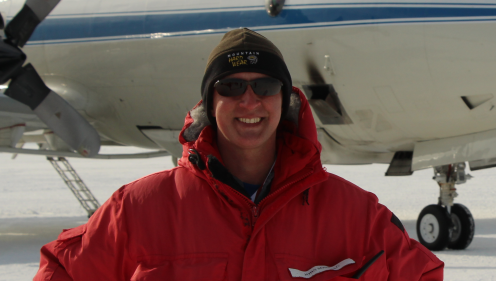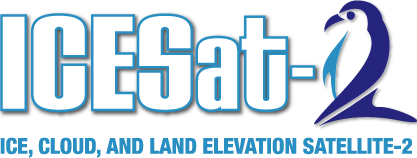
John Sonntag says every element of his job as a cryosphere scientist at NASA’s Goddard Space Flight Center in Greenbelt, Maryland, excites him.
“I am a geek in every sense of the word,” he said. “I’m a nerd about weather, about airplanes, about computers; I love that stuff. So the idea that you can put all that stuff together and make a job out of it, that someone’s going to pay you to do it? That’s awesome.”
Sonntag has been working in cryospheric science for 23 years. He started as an engineer, working on instruments that study ice, and then moved into fieldwork, travelling to the North and South poles, Antarctica and on nearly annual trips to Greenland. He loves the chance to travel while also studying the frozen parts of the world. He is currently a mission scientist for Operation IceBridge, which provides continuity to the record of measurements of land and sea ice taken by the Ice, Cloud and land Elevation Satellite (ICESat), until its successor, ICESat-2, launches in 2017. He calls his job one of the greatest privileges he can imagine.
“Few people in the world get to see the stuff that we see on a daily basis, as just a day at the office,” Sonntag said.
Tell me a little bit about what you do.
I do a number of things, but I guess my primary current title is mission scientist for Operation IceBridge, which means that I’m in charge of particular deployments of IceBridge. IceBridge incorporates a number of different airplanes, instruments and campaigns, some of which happen at the same time, even in different hemispheres. In the fall, we’re going to have one airplane working in Greenland and another working in Antarctica at the same time. My role as mission scientist is to be in charge of the field operations of one of those campaigns. I’m also senior scientist with the Airborne Topographic Mapper (ATM), which is an instrument team that maps polar ice sheets.
Is that similar to work being done in Greenland by the MABEL – Multiple Altimeter Beam Experimental Lidar – and SIMPL – Slope Imaging Multi-polarization Photon-counting Lidar – instruments?
It’s similar in a way. The work being done with MABEL and now SIMPL – which is the next generation associated with MABEL – is to support the ICESat-2 mission. They’re instrument simulators for ICESat-2, so they’re being deployed to learn things that will help to understand the data that ICESat-2 will send out. IceBridge is actually taking operational data in its own right, which can used to understand the data from other instruments and satellites, including ICESat-2, but that’s not its main purpose. Its main purpose is the data in itself; it’s operational science data meant to interpret the changes in polar ice.
What kind of data are you collecting?
The primary instrument is the Airborne Topographic Mapper, which makes a swath of topographic measurements [measurements of surface shape and features] directly beneath the aircraft that are usually a couple hundred meters wide and they’re very, very accurate and very, very detailed. It uses lidar, which works with a laser in the belly of an aircraft. The laser scans in a conical format, and fires thousands of laser shots every second. In our case, we get anywhere from 3,000 to 10,000 laser shots per second. Each one of those shots is a little pulse of light sent out from an airplane at a location we know, and it gets sent out in a direction we can measure very carefully. It works by tracking how long it takes the laser pulse to travel from the airplane and back, which we also measure very accurately. Put all that information together and you can assign latitude, longitude and altitude within a few centimeters to each laser beam. When you do that over hundreds of kilometers of a flight line, you wind up with this very detailed topography. If you fly over and map that same location a month or a year or five years later, now you can very accurately deduce the changes happening there, which is used for measuring changes in glaciers.
We also have a whole suite of radars that work at various frequencies. Some of them bounce right off the top of the ice sheet, very similar to what a lidar does, and they tell us more or less the same thing the lidar does, the surface topography. Others penetrate down deep to various depths within the ice, including one that goes all the way down the bedrock of the ice and that tells us how thick the ice is and also the shape of the bedrock. The shape and depth of the bedrock in particular says a lot about how the ice interacts with the oceans or other glaciers. Understanding the shape of that bedrock is really crucial to understanding what the glacier is going to do.
The radars in between look at the ice between the top and the bedrock and do a number of things like measure the thickness of the snow on top of sea ice, which we have no other way of getting at. They also study annual accumulation, which is like digging into tree rings but to study the age of ice. Each year, ice is deposited and then melts a little during the summer and is compressed on top and you can see individual layers of ice that correspond to specific years, which tells you a lot about climatology by looking at how the glacier has been changing over time. We put data from all those instruments together and try to create a very detailed package for the science community that can then be used to increase our knowledge of the world we live in.
What are some things scientists are doing with the information from IceBridge?
They’re doing lots of things. The primary reason for IceBridge -- and the ICESat and ICESat-2 satellite missions, which IceBridge is connecting-- is to measure sea level change. The primary reason that sea level is changing is because the polar ice sheets are changing. Parts of them shrink, parts of them grow, but in the net over the last couple of decades, they’ve been melting into the oceans and raising sea level. If you can measure how the shape and volume of the ice sheets are changing, you can understand how much sea level is rising and maybe more importantly, start to understand the processes behind the changes. The lasers tell us how the sea levels are changing, and the radars can help us understand why that might be happening. Together, that information can help us make predictions about the future, what the sea level might look like in 10 years or a hundred years or a thousand years, which can help society make adjustments to deal with that.
How long have you been working with the cryosphere?
I’ve been working around ice for about 23 years. I’ve been personally involved in ice measurements since the 1990s, and IceBridge didn’t come along until almost 20 years later. I travel to Greenland almost every year. Fifteen years ago, we might go to Greenland and stay three weeks and fly 15 missions and that was considered a big season. Now, we go for three months and we might fly 30 or 40 missions, so the scale of things has ramped up dramatically, largely because of IceBridge.
In that time, the data has shown very clearly how the ice sheets have changed around the world. The ice sheets are getting smaller and they’re raising the sea level. However, there’s a lot of nuance in that too. Different glaciers in different parts of the world do different things; one of the things we’ve seen pretty comprehensively around the world is glaciers that are in direct contact with the ocean tend to be the ones that are really diminishing quickly. We’re seeing a strong coupling between what happens with the oceans and what happens with the glaciers; and that coupling is a pretty new area of research that’s still being looked at right now and will be for a long time to come.

